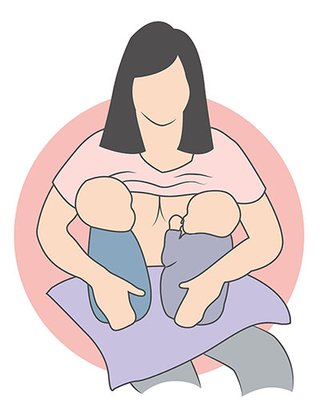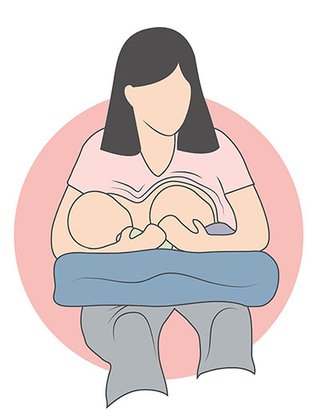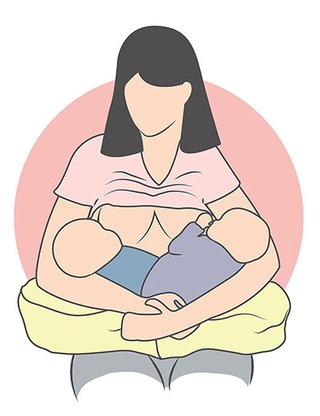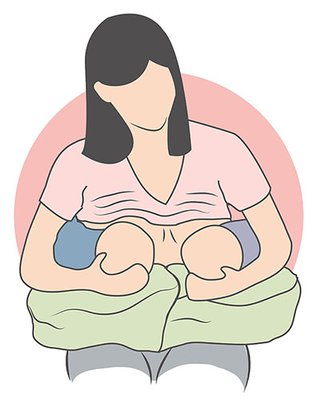Your body will produce more than enough breast milk for your babies if you have twins, triplets or more.
But finding time to breastfeed and manage life's demands can be daunting. Arrange plenty of help and support from family and friends.
Breastfeeding is the best option for your babies, particularly if they were born premature.
How to prepare during pregnancy
Your midwife or doctor will arrange a consultation with a breastfeeding specialist before the birth of your babies. This can be as early as 26 weeks.
Twin mothers are usually seen by an infant feeding specialist from 25 weeks onwards. This is because they are often admitted early due to premature labour or issues with their babies.
If you are admitted during pregnancy, ask your midwife to arrange a meeting with a breastfeeding specialist. You may be supported to harvest colostrum. This will depend on you and your babies' health.
How to get started
Soon after birth, uninterrupted skin-to-skin contact and breastfeeding are the key to making plenty of milk.
If either of the babies is small or not able to latch or feed effectively, you will be supported to express milk until your supply improves and breastfeeding is well-established.
At the start, you may find it easier to feed them separately. This will help to build your confidence. You can feed triplets with 2 babies together and then 1 alone, or rotate 1 by 1.
Aim to give as much breast milk as possible to your babies. The amount of breast milk you produce depends on how often and how effectively your babies feed. If your babies are unable to feed effectively, you will need to express milk to improve your supply.
Getting breastfeeding off to a good start
Expressing milk for a premature or ill baby
It will take time to find a position that you feel comfortable with. You may find it easier to concentrate on 1 baby at a time. If you'd like to feed 2 babies at once, ask your midwife or partner to help you when positioning and attaching.
Ask our breastfeeding experts
Deciding which babies to breastfeed when
Some mothers prefer to save time by feeding their babies together. Other mothers feed babies separately to enjoy personal time with each baby, or because a particular baby needs extra help.
Feeding them together may help the weaker baby. This is because the more effective baby can stimulate the milk flow, helping the less effective baby to get more milk more quickly.
Deciding which baby gets which side
Some mothers breastfeed with no particular plan, offering whichever side feels fuller to whichever baby seems hungrier at the time.
Other mothers offer the same breast to the same baby for the entire day, alternating sides every day.
If 1 baby is a less effective feeder, switching sides helps to stimulate both breasts equally to maintain good supply.
Breastfeeding your babies together
When you are confident 1 baby is well attached to your breast, you can try feeding 2 babies together. This will save you time.
Try the following positions to see what works best for you.
Upright latch position

Football and cradle pose

Front cross position

Double football position

In the early days, it's easier to feed in a bed or on a big sofa. Position yourself in the middle with plenty of cushions around you. This will help to support your back and to lift up your babies if needed.
There is no one right or wrong way to breastfeed multiples. Work out your own system that suits you and your babies best.
Whatever position you choose, make sure you are able to rest during your busy breastfeeding schedule.
Breastfeeding - positioning and attachment
Milk supply
Your breast milk is produced on demand. This means that the more you feed, the more you make. You will have plenty of milk for your babies if you feed on demand.
Breastfeeding multiples can be overwhelming. But partial breastfeeding is always a better option than no breastfeeding. Your public health nurse (PHN), midwife or lactation specialist will help you to develop a realistic plan that works best for you and your babies.
If your babies are small or born a little early, your midwife, lactation consultant or public health nurse will help. They can support you to make sure your babies are feeding well and gaining weight.
Keep a track of each baby's feeds and how many dirty nappies they do. Do this until they are gaining weight steadily.
Watch a video about breastfeeding twins
Deirdre McCarthy shares her advice on breastfeeding twins
Getting support
Breastfeeding support groups are a great place to get advice and to meet other mothers.
Breastfeeding support groups are run by:
- lactation consultants (IBCLCs)
- public health nurses
- La Leche League leaders
- Cuidiú breastfeeding counsellors
- Friends of Breastfeeding